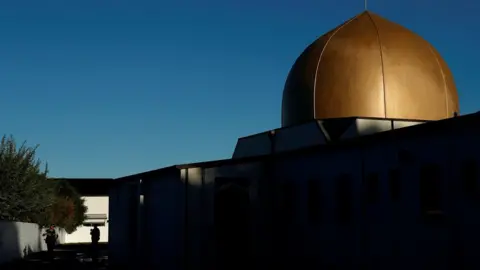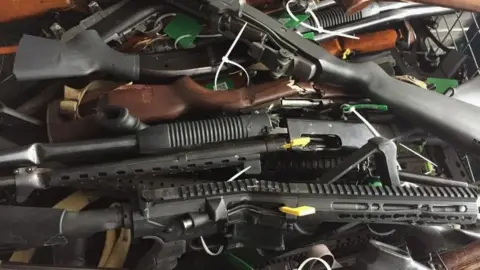Christchurch massacre: Inquiry finds failures ahead of attack
 Reuters
ReutersAn inquiry into the Christchurch massacre has found a series of failures ahead of the 2019 attack, but concluded the tragedy was unpreventable.
The inquiry was launched after white supremacist Brenton Tarrant killed 51 people at two mosques in March 2019.
It found he had been able to accumulate a massive trove of weapons, with authorities failing to enforce proper checks on firearms licences.
It further found officials were overly focused on Islamist terrorism.
However, correcting these failures would not have stopped the Australian national, who was sentenced to life in prison without parole earlier this year, from carrying out the attack, it said.
What's more, the patchwork of clues discovered by police after the massacre - including his steroid abuse, a hospital admission after he accidentally shot himself, and visits to far-right websites - would not have proved enough to predict the attack.
What did the commission find?
"The commission found no failures within any government agencies that would have allowed the terrorist planning and preparation to be detected," New Zealand Prime Minister Jacinda Ardern said after the release of the report.
"But they did identify many lessons to be learnt and significant areas that require change."
She highlighted "failings within the firearms licensing regime" and "inappropriate concentration of resources" on a perceived level of Islamist threats.
"While the commission made no findings that these issues would have stopped the attack, these were failings nonetheless and, for that, on behalf of the government I apologise."
The report includes a list of recommendations which the government said it would all accept, including establishing a new national intelligence and security agency and a proposal for the police to better identify and respond to hate crimes.
The government also plans to create an ethnic community ministry and a graduate programme for ethnic communities.
How did New Zealand's Muslim community react?
The imam of the Al Noor Mosque, one of the two places of worship targeted, said the report confirmed that authorities had been overly suspicious of the Muslim community instead of protecting it.
"We've known for a long time that the Muslim community has been targeted with hate speech and hate crimes - this report shows that we are right," Gamal Fouda said. "The report shows that institutional prejudice and unconscious bias exists in government agencies and that needs to change."
He stressed that the changes recommended in the report should now be used to rebuild the trust between the Muslim community and the police.
Aya Al-Umari, whose brother died in the attack, told the BBC that the report's recommendations highlighted "all the right areas".
"That is mainly: improving New Zealand's counter terrorism efforts, the firearm licensing, the social cohesion and New Zealand's response to the increasing diversity of our population," Ms Al-Umari said.
She also said she hoped New Zealand's experience would provide lessons to other countries, noting that the response would have to be at an individual level as well.
"We each play a part in reducing hate crimes and reducing our unconscious bias. That escalates to what we saw on March 15 last year."
However, the Islamic Women's Council of New Zealand criticised the report for what they said was a lack of transparency.
"There are multiple areas of evidence that have not been investigated, and questions raised by IWCNZ have been ignored," the group said.
"We find it concerning that the commissioners found systemic failures and an inappropriate concentration of resources towards Islamic terrorism, and yet state that these would not have made a difference to the terrorist being detected prior to the event."

What did the investigation uncover about the attacker?
The Australian national, who lived off his savings and a large inheritance from his father, got a firearms licence and began buying rifles, shotguns and ammunition soon after he arrived in New Zealand in 2017.
Later that year, he told a doctor he had been taking steroids and was injecting testosterone several times a week. The doctor warned against this, but no further treatment followed.
Over the following years, he visited far-right websites and occasionally posted right-wing material on his Facebook page. He also donated money to far-right groups overseas.
In 2018, he wounded himself in a firearms accident and was worried that seeking treatment might alert the police. He eventually went to hospital but his injury did no raise suspicion and was not reported.
In the run-up to the attack, he tried to conceal some of his digital footprint, but investigators were able to track in some detail his reconnaissance efforts, planning and preparation for the attack on 15 March.
None of the details uncovered by police after the massacre stood out at the time as something which would have raised suspicion from authorities, the report found.

What happened in Christchurch?
On 15 March, the Australian attacker opened fire on worshippers inside the Al Noor mosque, broadcasting the attack on Facebook Live via a headcam he was wearing.
He then drove to the Linwood Islamic Centre where he shot people outside and then shot at the windows.
A man from inside the centre rushed outside and picked up one of the attacker's shotguns before chasing him away.
Police officers then chased and arrested the gunman. After his arrest, the attacker told police that his plan was to burn down mosques after his initial attack and he wished he had done so.
During his sentencing in August this year, the court heard that he had planned to target another mosque, but was detained by officers on the way.
How did New Zealand respond?
Earlier this year, the attacker was sentenced to life in prison without parole. The judge called his actions "inhuman", saying he had "showed no mercy".
The massacre also prompted New Zealand to reform its gun laws.
Less than a month after the shootings, the country's parliament voted by 119 to 1 on reforms banning military-style semi-automatic weapons as well as parts that could be used to build prohibited firearms.
The government offered to compensate owners of newly-illegal weapons in a buy-back scheme.
 Getty Images
Getty ImagesWhile there was widespread praise for how New Zealand dealt with the tragedy in the aftermath, there was also criticism that authorities might have ignored warnings that hate crimes against the Muslim community were escalating.
In response to that, the government launched the the Royal Commission of Inquiry into the massacre. It is the highest level of independent inquiry available under New Zealand law.
The report took about 18 months to compile and contains interviews with hundreds of people including security agencies, Muslim community leaders and international experts.
"Ultimately, this roughly 800-page report can be distilled into one simple premise," Ms Ardern said.
"Muslim New Zealanders should be safe. Anyone who calls New Zealand home, regardless of race, religion, sex or sexual orientation should be safe."
